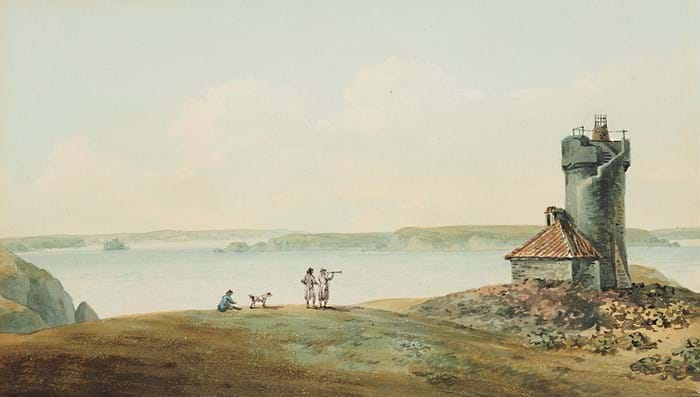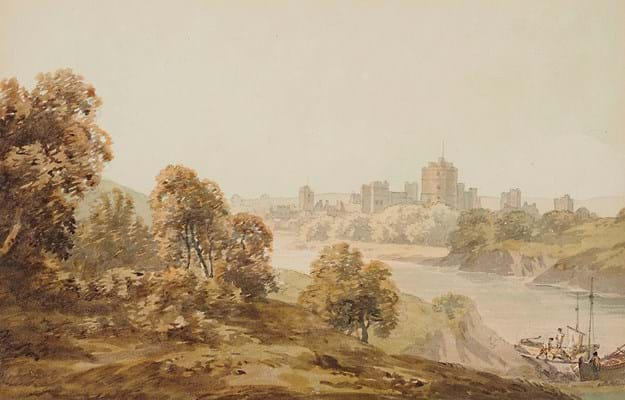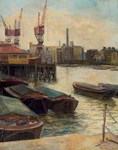While the French Revolutionary and Napoleonic wars raged from 1792-1815, British watercolourists were largely confined to home. Rather than seeking inspiration from European countryside, they turned to their native isle, painting views of Wales, Scotland or the Lake District.
With its dramatic coastlines and castles, Wales became a particularly popular destination for tourists and painters. In the vanguard of artists turning their attention to the area was John ‘Warwick’ Smith (1749-1831).
Between 1784-1806 the painter visited Wales 13 times, completing more than 700 watercolours of views from Benton Castle or Beaumaris to Milford Haven or Meifod.
All the works went into the collection of his patron, George Greville, 2nd Earl of Warwick (1746-1816), from whom the artist had his nickname, while engravings after his paintings were used to illustrate William Sotheby’s A Tour Through Parts of Wales… (1794) and Sir James Smith’s A Tour of Haford in Cardiganshire (1810).
A new London show, running from April 1-10 at Guy Peppiatt Fine Art in Mason’s Yard, St James’s, showcases 21 of Smith’s Welsh pictures from seven of his trips.
Each is offered for around £2000- 3000 – relatively low compared to some of Smith’s best-known Italian scenes. These were completed during two tours of Italy, both sponsored by Greville, in the 1770s-80s, and today can sell for more than £10,000.
These pictures are rather lovely – it’s a nice group and a chance to get visitors interested in the artist
While in Europe, Smith met leading watercolourists of his day such as Francis Towne (1739-1816) and, significantly, Welsh artist Thomas Jones (1742-1803) who may have sparked his interest in the British region.
Initially, the paintings in the show, all measuring around 5 x 8in (13 x 20.5cm), were probably bound together in albums and later dispersed among Greville’s descendants. Peppiatt came across all but two of the works included in the show at US auctions. None were attributed.
“This is a general problem with watercolours,” he says. “If they aren’t signed they will often lose their attribution unless, in some cases, they are very typical of the artist. If they started out in an album, why would they need to be signed?”

'The Eastern Lighthouse on St Anne’s Head at the Entrance to Milford Haven from St George’s Channel, Pembrokeshire', watercolour over pencil heightened with touches of bodycolour on laid paper – £3000 at the Guy Peppiatt Fine Art exhibition of works by John ‘Warwick’ Smith.
Peppiatt could identify the works from the characteristic long inscriptions to the back of each composition. These titles are distinctive, done in the artist’s hand, and are peculiar to his Welsh pictures.
One of the briefest reads: General View of the Interesting Ruins of Pembroke Castle, on Pennarmouth Creek with part of the Town of Pembroke/Taken from the Grounds of John Meyrick Esq.r at Bush.
Offered for £2800, the scene shows Pembroke Castle, which had its origins in the 11th century and was the only castle never to have fallen to the Welsh.
It survived numerous sieges until Oliver Cromwell blew up the barbican and fronts of the towers in 1648 to render it useless. In the picture its ruins are visible as a picturesque detail.
Today, the structure has been extensively restored and the painting serves as a historic document of the castle and town.
“These pictures are rather lovely,” says Peppiatt. “It is a nice group and a chance to get visitors interested in the artist. No one has really done a show on his works since the Wordsworth Trust several years ago and I think he’s quite underappreciated.”
The exhibition was prepared with the support of Sarah Hobrough, who recently joined the gallery as a consultant.


















